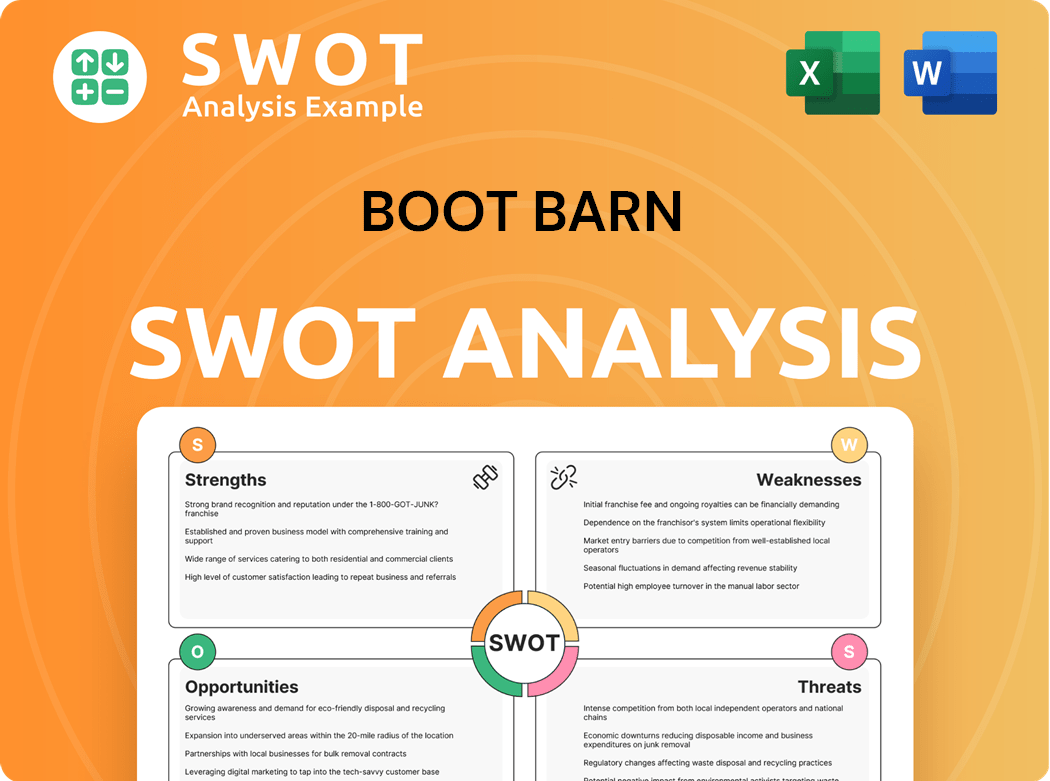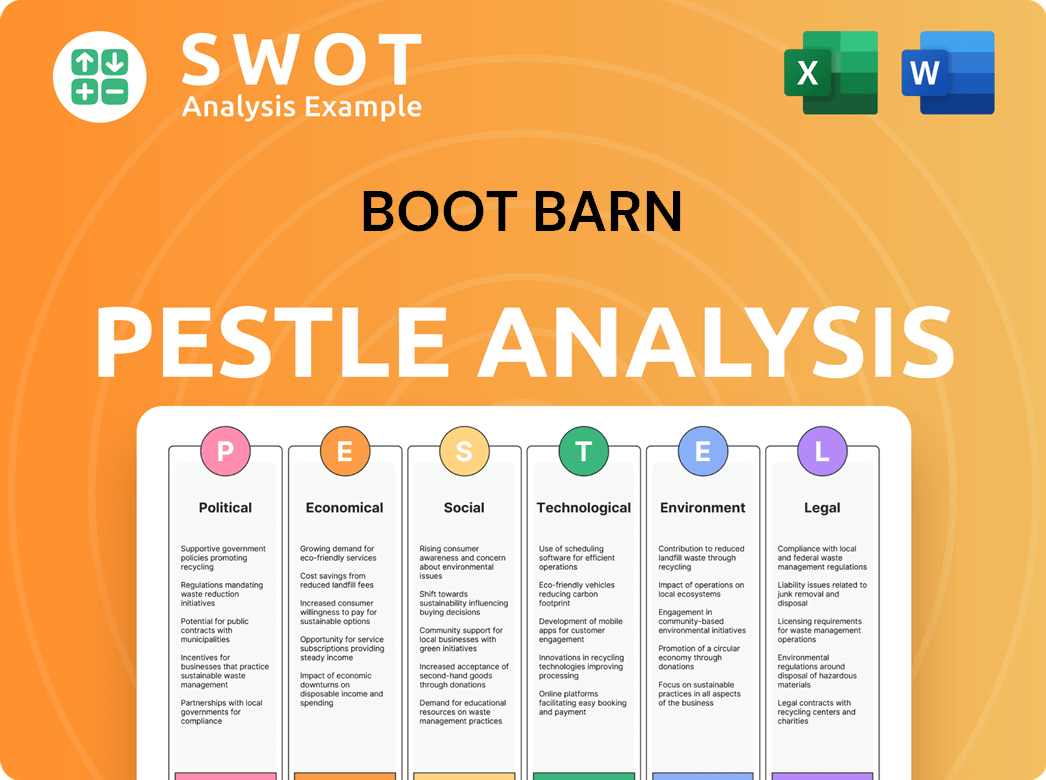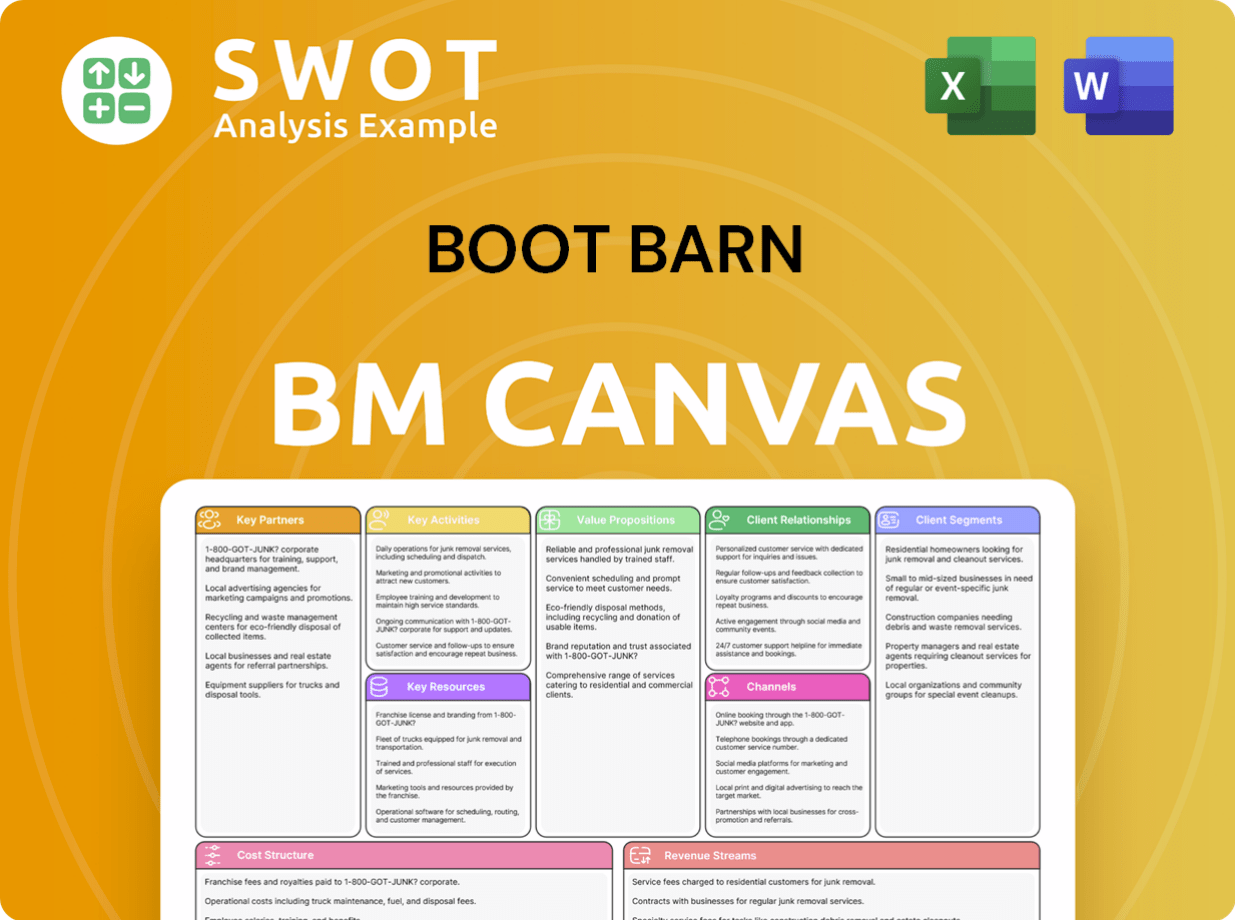Boot Barn Bundle
Can Boot Barn Conquer the Competitive Retail Arena?
In a retail world dominated by online giants, how does Boot Barn, a brick-and-mortar retailer, thrive? Boot Barn Holdings, Inc. has carved a unique niche in the Boot Barn SWOT Analysis, focusing on western and work-related wear. This analysis explores the company's journey from a single store to a nationwide presence, highlighting its strategic approach to market dominance.

This deep dive into the Boot Barn competitive landscape examines its key rivals and its market position within the Western wear industry. We will analyze Boot Barn's market share analysis alongside its financial performance compared to competitors, revealing the strategies that fuel its success. Understanding the competitive advantages of Boot Barn is crucial for investors and strategists alike, offering insights into its ability to navigate retail competition and maintain its strong brand perception.
Where Does Boot Barn’ Stand in the Current Market?
Boot Barn holds a prominent market position within the western and work-related footwear and apparel sector. The company's core operations revolve around providing a wide array of products specifically tailored to customers interested in western wear and work-related attire. This includes boots, apparel, and accessories, catering to a diverse demographic.
The value proposition of Boot Barn centers on offering durable, authentic, and specialized products. This focus has allowed it to build a strong brand reputation and customer loyalty. The company's extensive store network and expanding e-commerce presence further enhance its ability to reach and serve its target market effectively.
As of early 2024, Boot Barn operates over 390 stores across 44 states, showcasing its significant market penetration. This extensive presence, particularly in the Southern and Western United States, supports its leadership in the western and work-related retail industry. The company's financial health remains robust, with net sales for fiscal year 2024 projected to be between $1.673 billion and $1.683 billion, indicating continued growth.
Boot Barn's market share in the niche western and work-related footwear and apparel industry is substantial. While specific figures are proprietary, the company's extensive store network demonstrates strong market penetration. The company's strategic expansion and consistent focus on its core customer segments have contributed to its market leadership.
Boot Barn's primary target market includes agricultural workers, tradespeople, and individuals embracing a western lifestyle. The company's product offerings are designed to meet the needs of these diverse customer segments. This focus allows Boot Barn to maintain a loyal customer base and effectively compete within the retail competition.
Boot Barn offers a comprehensive range of western and work boots, denim, shirts, outerwear, hats, belts, and accessories. This broad selection caters to the diverse needs of its customer base. The company's focus on providing high-quality, durable products supports its market position.
Boot Barn has expanded its geographic presence beyond its Californian roots to establish a national footprint. The company's expansion strategy has been particularly strong in the Southern and Western United States. This strategic growth supports its ability to capture and retain market share.
Boot Barn's competitive advantages include its extensive store network, strong brand reputation, and focus on specialized products. The company's ability to adapt to market shifts, such as enhancing its e-commerce capabilities, further strengthens its position. For a deeper understanding of Boot Barn's strategic moves, you can read about the Growth Strategy of Boot Barn.
- Extensive store network and e-commerce presence.
- Strong brand reputation and customer loyalty.
- Focus on specialized product offerings.
- Strategic geographic expansion.
Boot Barn SWOT Analysis
- Complete SWOT Breakdown
- Fully Customizable
- Editable in Excel & Word
- Professional Formatting
- Investor-Ready Format

Who Are the Main Competitors Challenging Boot Barn?
The Boot Barn competitive landscape is shaped by a mix of direct and indirect rivals within the western wear industry and broader retail sectors. Understanding these competitors is crucial for a comprehensive Boot Barn market analysis. The company faces challenges from both specialized retailers and large general merchandise stores, each vying for market share through different strategies.
Boot Barn's ability to maintain its position depends on factors like product selection, customer service, and omnichannel capabilities. The competitive dynamics involve promotional activities, exclusive brand partnerships, and expansion into new territories. Analyzing the strengths and weaknesses of each competitor is essential for evaluating Boot Barn's strategic positioning and future growth prospects.
The competitive environment requires continuous adaptation and innovation to stay ahead. Boot Barn must effectively navigate the evolving retail landscape, focusing on product authenticity, brand variety, and customer experience. The following sections will delve into the key players influencing Boot Barn's market performance.
Direct competitors pose the most immediate threat to Boot Barn's market share. These rivals offer similar products and target the same customer base. They often compete on factors such as pricing, product selection, and store location.
Tractor Supply Company is a major direct competitor, particularly in rural areas. While it offers a broader range of products, it dedicates significant retail space to workwear and western apparel. In 2024, Tractor Supply reported net sales of approximately $14.6 billion, indicating its substantial presence in the market.
Cavender's Boot City is a well-established, family-owned business with a strong regional presence, especially in the Southern United States. It offers a similar range of western wear and has built strong brand loyalty. Cavender's has a significant number of store locations across multiple states.
Indirect competitors offer similar products but may not specialize in western wear. These retailers often compete on price and convenience. They can impact Boot Barn's market share, especially for commoditized items.
Walmart offers a selection of work and western-style apparel at competitive price points. Its vast reach and established supply chain allow it to compete effectively on price. In 2024, Walmart's revenue reached over $648 billion, demonstrating its significant market influence.
Amazon offers a wide range of work and western wear through its online platform. Its competitive pricing and vast selection pose a challenge to brick-and-mortar retailers. Amazon's net sales in 2024 were approximately $575 billion.
The western wear industry also includes smaller, independent boutiques and direct-to-consumer brands. These competitors focus on niche preferences and personalized customer service. They leverage digital marketing and streamlined supply chains.
- Independent Boutiques: Offer unique products and personalized service, catering to specific customer preferences.
- Direct-to-Consumer Brands: Utilize digital marketing and streamlined supply chains to reach consumers directly.
- Online Retailers: Compete through a wide selection and competitive pricing, often specializing in specific categories.
- Specialized Brands: Focus on particular segments within work or western wear, offering specialized products.
Boot Barn PESTLE Analysis
- Covers All 6 PESTLE Categories
- No Research Needed – Save Hours of Work
- Built by Experts, Trusted by Consultants
- Instant Download, Ready to Use
- 100% Editable, Fully Customizable

What Gives Boot Barn a Competitive Edge Over Its Rivals?
The competitive advantages of the company are rooted in its specialized focus, extensive physical presence, and deep understanding of its target customer. Its dedication to western and work-related footwear, apparel, and accessories enables it to offer a highly specialized inventory that general retailers struggle to match. This curated selection, including leading brands, appeals to a customer base that values durability, authenticity, and specific functionalities, setting the stage for strong brand loyalty.
A key strength is its wide network of stores. This extensive brick-and-mortar footprint, combined with a growing e-commerce platform, provides a robust omnichannel approach. The stores serve as community hubs, reinforcing brand loyalty through knowledgeable staff and a tailored shopping experience. The company's ability to manage its supply chain and inventory for specialized products further enhances its operational efficiencies.
Furthermore, it benefits from strong relationships with key vendors, enabling it to offer exclusive products and competitive pricing. Its established brand equity within the western and workwear community fosters significant customer loyalty, built on trust and a reputation for quality. These advantages are sustainable due to the niche nature of the market and the significant investment required to replicate its scale and specialized expertise. To learn more about the company's origins, you can read Brief History of Boot Barn.
The company's focus on western and work-related products allows for a highly specialized inventory. This includes a wide selection of boots, apparel, and accessories from leading brands. This specialization caters to a specific customer base, providing a competitive edge in the Boot Barn competitive landscape.
With over 390 stores across 44 states, the company has a significant physical presence. This broad network provides convenient access for its target demographic. These stores also serve as community hubs, reinforcing brand loyalty.
The company benefits from robust relationships with key vendors. These relationships enable it to offer exclusive products and competitive pricing. This advantage helps in maintaining a strong position within the Western wear industry.
Established brand equity within the western and workwear community fosters significant customer loyalty. This loyalty is built on trust and a reputation for quality. This strong brand perception is crucial in the face of Retail competition.
The company's competitive advantages include a specialized product focus, extensive store network, and strong vendor relationships. These factors contribute to a strong market position, making it a key player in the Boot Barn market analysis.
- Specialized Product Selection: Focus on western and work-related goods.
- Extensive Store Network: Over 390 stores across 44 states.
- Strong Vendor Relationships: Enables exclusive products and competitive pricing.
- Customer Loyalty: Built on trust and a reputation for quality.
Boot Barn Business Model Canvas
- Complete 9-Block Business Model Canvas
- Effortlessly Communicate Your Business Strategy
- Investor-Ready BMC Format
- 100% Editable and Customizable
- Clear and Structured Layout

What Industry Trends Are Reshaping Boot Barn’s Competitive Landscape?
The retail landscape for western and workwear is shaped by several factors, including e-commerce growth, shifting consumer preferences, and economic conditions. To stay competitive, the company must invest in its digital presence and omnichannel capabilities. Understanding the Boot Barn competitive landscape is crucial for strategic planning.
The company faces challenges such as managing supply chain disruptions and navigating economic downturns. Increased competition from private labels and direct-to-consumer brands also poses a threat. However, opportunities exist for expansion, product diversification, and strategic partnerships. A deep dive into the Boot Barn market analysis is essential for understanding these dynamics.
The Western wear industry is experiencing a surge in online sales, with e-commerce playing a larger role. Consumers are increasingly seeking versatile, comfortable, and sustainable apparel. This shift demands that companies adapt their strategies to meet these evolving needs.
Managing supply chain disruptions and economic downturns are significant hurdles. Increased Retail competition from private labels and direct-to-consumer brands also poses a threat. Attracting and retaining skilled labor in retail stores remains an ongoing challenge.
Expansion into new geographic markets, particularly in growing agricultural or industrial areas, offers growth potential. Product line diversification and strategic partnerships can unlock new customer segments. Leveraging data analytics can also enhance profitability.
Continued strategic store expansion and an enhanced omnichannel model are key. Focusing on authentic and functional products helps cater to evolving customer demands. The company's ability to adapt and innovate will be crucial for success.
To thrive in the competitive landscape, the company must focus on several key areas. These include expanding its store footprint, enhancing its online presence, and understanding its target market.
- Strategic store expansion, particularly in regions with strong western heritage or growing industrial sectors.
- Enhancement of the omnichannel model to provide seamless shopping experiences.
- Product innovation to meet evolving consumer preferences for comfort and sustainability.
- Leveraging data analytics to personalize customer experiences and optimize inventory.
- Strategic partnerships to broaden market reach and product offerings.
For further insights into how the company can navigate these challenges and opportunities, consider reading about the Growth Strategy of Boot Barn. The company's ability to adapt and innovate will be critical for maintaining its competitive position. The company's strategic moves in recent years show its commitment to growth. In fiscal year 2024, the company reported net sales of approximately $1.7 billion, reflecting its strong market presence and strategic initiatives. The company's focus on both physical and online retail, with approximately 370 stores as of early 2024, allows it to reach a broad customer base. The company's success also depends on its ability to manage its supply chain effectively and adapt to changing consumer preferences. The company must continue to refine its strategies to stay competitive in the dynamic retail environment.
Boot Barn Porter's Five Forces Analysis
- Covers All 5 Competitive Forces in Detail
- Structured for Consultants, Students, and Founders
- 100% Editable in Microsoft Word & Excel
- Instant Digital Download – Use Immediately
- Compatible with Mac & PC – Fully Unlocked

Related Blogs
- What are Mission Vision & Core Values of Boot Barn Company?
- What is Growth Strategy and Future Prospects of Boot Barn Company?
- How Does Boot Barn Company Work?
- What is Sales and Marketing Strategy of Boot Barn Company?
- What is Brief History of Boot Barn Company?
- Who Owns Boot Barn Company?
- What is Customer Demographics and Target Market of Boot Barn Company?
Disclaimer
All information, articles, and product details provided on this website are for general informational and educational purposes only. We do not claim any ownership over, nor do we intend to infringe upon, any trademarks, copyrights, logos, brand names, or other intellectual property mentioned or depicted on this site. Such intellectual property remains the property of its respective owners, and any references here are made solely for identification or informational purposes, without implying any affiliation, endorsement, or partnership.
We make no representations or warranties, express or implied, regarding the accuracy, completeness, or suitability of any content or products presented. Nothing on this website should be construed as legal, tax, investment, financial, medical, or other professional advice. In addition, no part of this site—including articles or product references—constitutes a solicitation, recommendation, endorsement, advertisement, or offer to buy or sell any securities, franchises, or other financial instruments, particularly in jurisdictions where such activity would be unlawful.
All content is of a general nature and may not address the specific circumstances of any individual or entity. It is not a substitute for professional advice or services. Any actions you take based on the information provided here are strictly at your own risk. You accept full responsibility for any decisions or outcomes arising from your use of this website and agree to release us from any liability in connection with your use of, or reliance upon, the content or products found herein.